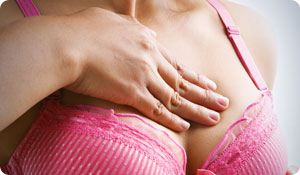
Aches and pains in breasts are common and usually no cause for alarm. For some women, however, sore breasts are a sign that something more serious is going on.
Breast pain is called myalgia. The American Congress of Obstetricians and Gynecologists (ACOG) explains what's going on inside our breasts:
Your breast is made up of glands, fat, and fibrous tissue. Each breast has 15-20 sections, called lobes. Each lobe has many smaller lobules. The lobules end in dozens of tiny glands that can produce milk. The lobes, lobules, and glands are linked by thin tubes called ducts. Your breasts respond to changes in levels of the hormones progesterone and estrogen.
So why do they hurt?
1) Menstrual changes. Approximately 75 percent of women experience mild to moderate breast tenderness for several days before their period. Some start feeling "the ache" right after ovulation. This is called cyclic breast pain and it is caused by hormonal fluctuations causing mild inflammation in the breast tissue. This tends to go away rapidly after your period starts.
2) Fibrocystic breast changes. Women with fibrocystic breasts have lumpy, tender breasts caused by alterations in the way their fibrous tissue forms. These lumps and bumps are not cancer or any type of disease and they don't increase your risks for cancer. They're normal variations in healthy breast tissue. They tend to become sore near your menstrual cycle because they become inflamed with hormonal changes. It's important to do regular breast self-exams so you know what lumps are normal for you and what are different and need to be checked by a doctor.
3) Medication side effects. Women taking any type of hormone including oral contraceptives, hormone replacement therapy and infertility treatments often experience breast tenderness as a normal side effect. Some women complain of breast pain while taking antidepressants too.
4) Pregnancy. Most of the changes that occur in the breasts that get them ready for breastfeeding happen in the first few months of pregnancy. Important hormonal changes that occur shortly after conception start milk glands and ducts to develop. Breast tissue swells and becomes tender in response to rapid growth. The tenderness tends to settle down after the first trimester.
5) Breast disease,It is often said that breast cancer doesn't hurt, but many women, doctors, and scientists say that's not necessarily true. Very early breast cancers are usually not painful, but as they grow, they press on other breast and chest wall tissues and invade lymph nodes. This can cause pain.
Other types of painful breast disease are:
- Mastitis - inflammation/infection of the milk ducts or glands.
- Non-cancerous cysts - fluid-filled sacs inside breast tissue.
6) Poorly fitting bra. Researchers say that 80 percent of women wear the wrong-sized bra. This can cause elastic straps, underwires and itchy cups to dig into our breasts. Have a professional bra fitting every year, or whenever you have significant weight gain or loss.
Whenever you notice any unusual breast pains, lumps or skin changes, see your doctor and have them evaluated. Ask your gynecologist to teach you how to perform breast self-exam and when you should start having regular mammograms.
Sources:
American Congress of Obstetricians and Gynecologists
Fibrocystic Breast Changes
http://www.acog.org/publications/patient_education/bp138.cfm





